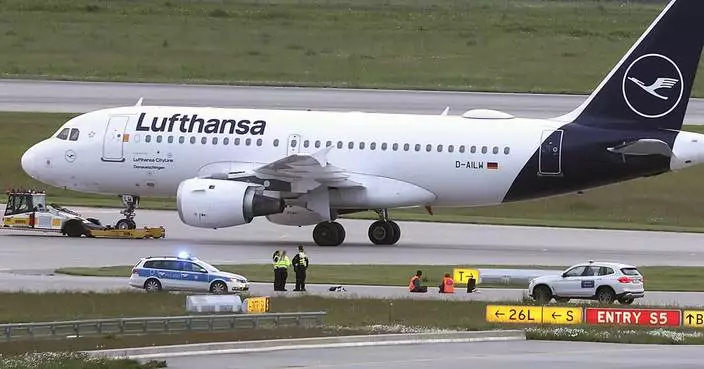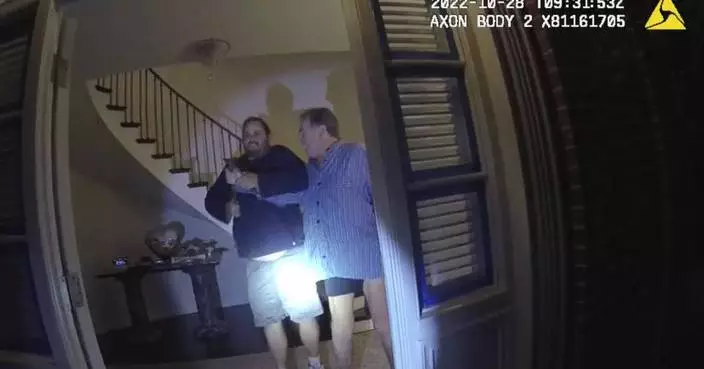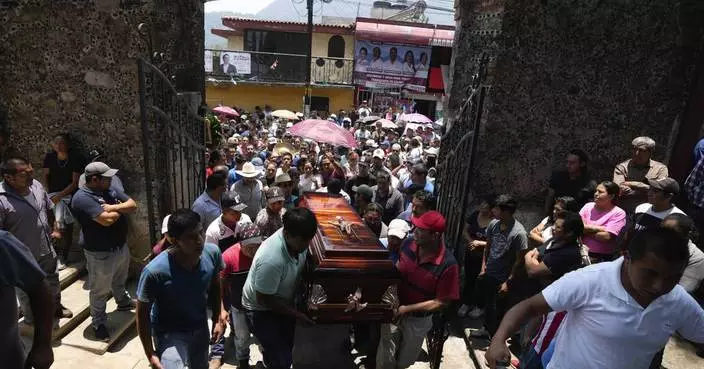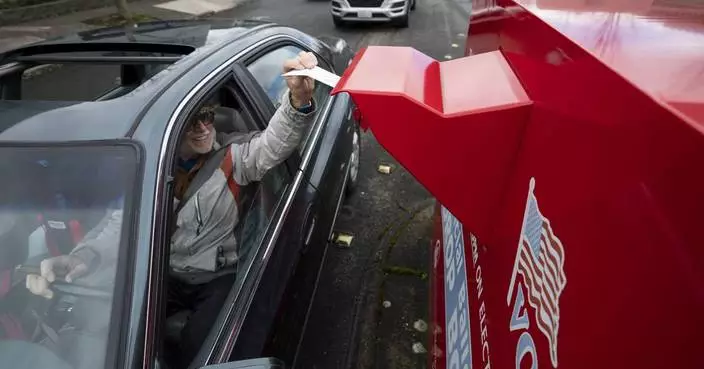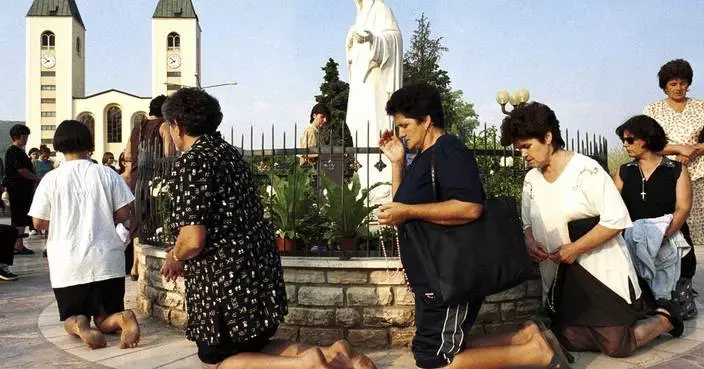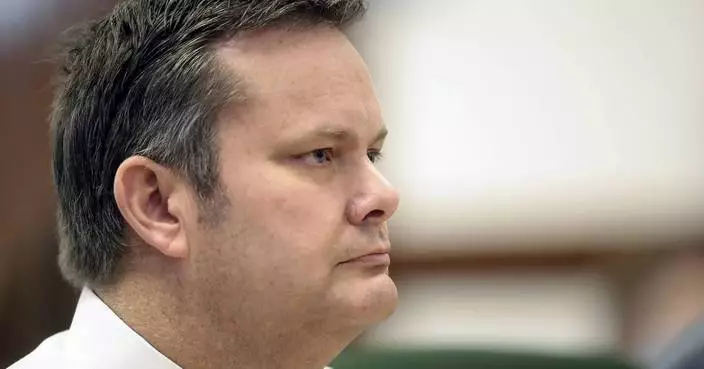Three vanished film students whose case had become emblematic of Mexico's 30,000 missing people were killed after being caught unaware in the midst of a drug gang turf battle, officials say.

Students protest the murder of three film students who have become emblematic of Mexico's missing, in Mexico City, Tuesday, April 24, 2018. (AP Photo/Eduardo Verdugo)
Prosecutors in the western state of Jalisco said late Monday the three were abducted by the Jalisco New Generation Cartel because they were filming a school project at a house used by the rival Nueva Plaza gang. The students were using the residence on the outskirts of the city of Guadalajara because it belonged to one of their aunts.
"Without knowing it, the students were in a very dangerous place which was being watched by hit men from the New Generation cartel," the prosecutor's office said. The aunt was implicated in a human trafficking case involving prostitution at massage parlors in the city of Guadalajara.
The students' fate horrified Mexico: Prosecutors said they were killed and their bodies dissolved in acid.

A student holds a sign that reads in Spanish "Mexico: The country where there are funeral wreaths at universities" during a protest against the murder of three film students who have become emblematic of Mexico's missing, in Guadalajara, Mexico, Tuesday, April 24, 2018. (AP Photo/Refugio Ruiz)
"Words can't describe the dimension of this madness," Oscar-winning Mexican director Guillermo del Toro wrote on Twitter. "Three students are killed and dissolved in acid. The 'why' is unthinkable, the 'how' is terrifying."
The killing appeared to be a case of mistaken identity.
Prosecutors said the New Generation cartel lookouts who were watching the house mistook the students for rival gang members and abducted them on a road after they left the house.
Prosecutors said the gang took the students to a safe house and interrogated them. The gang beat one student so badly he died, leading them to kill the other two, officials said. They then took them to another house, where prosecutors found jugs and tubs of sulfuric acid.
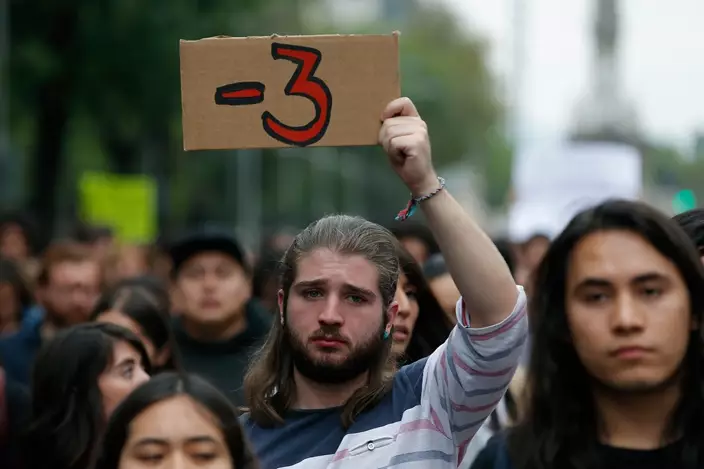
A student holds up a sign to protest the murder of three film students who have become emblematic of Mexico's missing, in Mexico City, Tuesday, April 24, 2018. (AP Photo/Eduardo Verdugo)
Traces of blood and the DNA of two of the students were found at the houses.
Two suspects have been arrested and several others are being sought. Officials close to the investigation said one of the suspects arrested is a local rapper who has some following on social media.
Investigators also found fake detectives' credentials at the houses, and prosecutors said the killers apparently posed as detectives when they pulled the students over.
One gang leader had already been arrested at the aunt's house in 2015 and police had received reports of armed men hanging out at the property in 2017.
"The effects of crime and violence against any person is bad enough, but it is worse when it is a case of young people who have a future, who are studying, who are working for Mexico," said Luis Gonzalez Perez, president of the country's National Human Rights Commission.
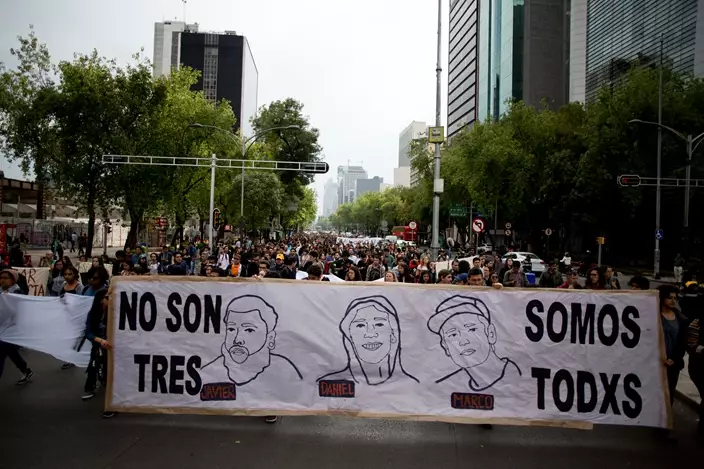
Students march with a sign that says in Spanish "It's not three. It's all of us." to protest the murder of three film students who have become emblematic of Mexico's missing, in Mexico City, Tuesday, April 24, 2018. (AP Photo/Eduardo Verdugo)
Condolences for the victims' families also came in from the country's film institute and candidates in the July 1 presidential elections.
KYIV, Ukraine (AP) — A divisive mobilization law in Ukraine came into force on Saturday, as Kyiv struggles to boost troop numbers after Russia launched a new offensive that some fear could close in on Ukraine’s second-largest city.
The legislation, which was watered down from its original draft, will make it easier to identify every conscript in the country. It also provides incentives to soldiers, such as cash bonuses or money toward buying a house or car, that some analysts say Ukraine cannot afford.
Lawmakers dragged their feet for months and only passed the law in mid-April, a week after Ukraine lowered the age for men who can be drafted from 27 to 25. The measures reflect the growing strain that more than two years of war with Russia has had on Ukraine’s forces, who are trying to hold the front lines in fighting that has sapped the country’s ranks and stores of weapons and ammunition.
Ukrainian President Volodymyr Zelenskyy also signed two other laws Friday, allowing prisoners to join the army and increasing fines for draft dodgers fivefold. Russia enlisted its prisoners early on in the war, and personnel shortages compelled Ukraine to adopt the new, controversial measures.
Oleksii, 68, who runs a car repair shop in Kyiv, worries his business will have to shut down as he expects 70% of his workers will be mobilized. He asked that only his first name be used to allow him to speak freely.
“With the new law, people will be mobilized and we will have to shut down and stop paying taxes,” Oleksii told The Associated Press on Saturday. He said it's very difficult to replace workers because of their specialized skills. Most of them are already in the armed forces, he said, adding that the law is “unfair” and “unclear.”
Even essential municipal services will be affected. Viktor Kaminsky, the head of a municipal service department in Kyiv that fits households with heating and repairs utilities in public buildings, said he will struggle to replace mobilized staff and meet demand, even though the law allows him to retain half of workers deemed fit for service.
He said 60 of the 220 people working in Kaminsky's department will be eligible to be called up. “If they take 30 people from what we have, the problem is we don’t have anyone to replace them," he said.
“There are pros and cons to this law,” Kaminsky said. “It's hard to avoid the mobilization process now, compared to before when people were trying to get around it.” But, he said, it would be better if essential workers like his were granted more exemptions.
Meanwhile, Oleksii Tarasenko, a deputy commander of a Ukrainian assault battalion, told AP that his men felt “awful” about the law's failure to address the issue of demobilization. Although many Ukrainian troops have been fighting since the war's early days, it remains unclear when and how they might be relieved of duty.
“It feels like a cruel injustice towards people who have been fighting for two years, and of course, it has a highly negative effect on the psychological state of soldiers and their families,” Tarasenko said.
Early drafts of the law envisaged the demobilization of troops after 36 months, and the rotation of those serving on the front line for more than half a year. These clauses were dropped following a last-minute appeal by Ukraine's military leadership, concerned that the armed forces would be left without their best-trained and most experienced troops. The Ukrainian Defense Ministry is working on a separate demobilization law.
Tarasenko said that despite their weariness, his comrades could see the generals' point.
“We already see how many people are lacking, especially professional troops in the units. And simply allowing such professional people who have been through a lot to demobilize would be wrong," he said.
Ukraine has struggled for months to replenish depleted forces, as Russian troops are pushing ahead with a ground offensive that opened a new front in the northeast and put further pressure on Kyiv’s overstretched military. After weeks of probing, Moscow launched the new push knowing that Ukraine suffered personnel shortages, and that its forces have been spread thin in the northeastern Kharkiv region.
Moscow’s forces have pummeled Kharkiv with strikes in recent weeks, hitting civilian and energy infrastructure and prompting angry accusations from Zelenskyy that the Russian leadership sought to reduce the city to rubble. Mayor Ihor Terekhov said that five people were injured on Saturday in a Russian airstrike that hit a residential area. On Friday, Terekhov reported that Russian guided bombs killed at least three Kharkiv residents and injured 28 others.
Moscow denies deliberately targeting civilians, but thousands have died or suffered injuries in the more than 27 months of fighting.
Kharkiv regional Gov. Ihor Syniehubov on Saturday said that nearly 10,000 civilians had to be evacuated from front-line areas near the Russian border. Only 100 residents remain in Vovchansk, the border town at the center of Moscow's grinding push that's now largely in ruins. The town had a pre-war population of over 17,400.
The U.S. last week announced a new $400 million package of military aid for Ukraine, and President Joe Biden has promised that he would rush badly needed weaponry to the country to help it stave off Russian advances. Still, only small batches of U.S. military aid have started to trickle into the front line, according to Ukrainian military commanders, who said it will take at least two months before supplies meet Kyiv’s needs to hold the line.
Rusyn is the head of recruitment for the 3rd Assault Brigade, one of the most popular among Ukrainian volunteers. He told AP that he saw a 15% increase in men joining the brigade, which fights in eastern Ukraine, in the past months. Most recruits are aged between 23-25, he said. For security reasons, he and his recruits asked to be identified by their call signs only.
“There is no alternative (to mobilization),” said Rohas, a 26-year old recruit. “One way or another, I believe that most men will end up in the ranks of the armed forces and by joining as a volunteer, you still get some preferences.”
“Those who are afraid of being mobilized are not the ones hostage to this situation, it's those (soldiers) who are standing in formations of three where there should be 10. Those guys are hostages to this situation and they should be replaced, so that’s why we are here," Rohas said.
Many Ukrainians have fled the country to avoid the draft since Russia’s all-out invasion in February 2022.
The Supreme Court last month said that 930 people were convicted of avoiding mobilization in 2023, a fivefold increase from the previous year.
Around 768,000 Ukrainian men aged 18-64 had been granted temporary protection in European Union countries as of last November, according to data from the bloc's statistical agency, Eurostat.
Kyiv has barred men under 60 from leaving the country since the start of the war, but some are exempt, including those who are disabled or have three or more dependent children. The Eurostat data does not specify how many of the men who have qualified for protection belong to these categories, nor how many others reached the EU from Ukraine's Russian-occupied territories in the east and south.
Unable to cross the border legally, some Ukrainian men risk death trying to swim across a river that separates Ukraine from neighboring Romania and Hungary.
Late on Friday, Ukraine’s border service said that at least 30 people have died trying to cross the Tisza River since the full scale-invasion.
Romanian border guards days earlier retrieved the near-naked, disfigured body of a man that appeared to have been floating in the Tisza for days, and is the 30th known casualty, the Ukrainian agency said in an online statement. It said the man has not yet been identified.
Kozlowska reported from London. Associated Press writer Alex Babenko in Kyiv, Ukraine contributed to this report.
——
Follow AP’s coverage at https://apnews.com/hub/russia-ukraine

Newly recruited soldiers of the 3rd assault brigade train in Kyiv, Ukraine, Friday, May 17, 2024. A divisive mobilisation law in Ukraine came into force on Saturday, as Kyiv struggles to boost troop numbers after Russia launched a new offensive. (AP Photo/Efrem Lukatsky)

Newly recruited soldiers of the 3rd assault brigade train in Kyiv, Ukraine, Friday, May 17, 2024. A divisive mobilisation law in Ukraine came into force on Saturday, as Kyiv struggles to boost troop numbers after Russia launched a new offensive. (AP Photo/Efrem Lukatsky)

A newly recruited soldier of the 3rd assault brigade trains, in Kyiv, Ukraine, Friday, May 17, 2024. A divisive mobilisation law in Ukraine came into force on Saturday, as Kyiv struggles to boost troop numbers after Russia launched a new offensive. (AP Photo/Efrem Lukatsky)

Newly recruited soldiers of the 3rd assault brigade train in Kyiv, Ukraine, Friday, May 17, 2024. A divisive mobilisation law in Ukraine came into force on Saturday, as Kyiv struggles to boost troop numbers after Russia launched a new offensive. (AP Photo/Efrem Lukatsky)

Newly recruited soldiers of the 3rd assault brigade train in Kyiv, Ukraine, Friday, May 17, 2024. A divisive mobilisation law in Ukraine came into force on Saturday, as Kyiv struggles to boost troop numbers after Russia launched a new offensive. (AP Photo/Efrem Lukatsky)

Oleksii, 68, director of the auto repair shop poses for photo in Kyiv region, Ukraine, Saturday, May 18, 2024. A divisive mobilisation law in Ukraine came into force on Saturday, as Kyiv struggles to boost troop numbers after Russia launched a new offensive. (AP Photo/Alex Babenko)

A newly recruited soldier of the 3rd assault brigade trains, in Kyiv, Ukraine, Friday, May 17, 2024. A divisive mobilisation law in Ukraine came into force on Saturday, as Kyiv struggles to boost troop numbers after Russia launched a new offensive. (AP Photo/Efrem Lukatsky)

Smoke rises after a Russian attack in Kharkiv, Ukraine, Friday, May 17, 2024. (AP Photo/Evgeniy Maloletka)

People walk on a street while smoke rises after a Russian attack in Kharkiv, Ukraine, Friday, May 17, 2024. (AP Photo/Evgeniy Maloletka)

Foreign journalists report from an observation point while smoke rises after a Russian attack in Kharkiv, Ukraine, Friday, May 17, 2024. (AP Photo/Evgeniy Maloletka)

















